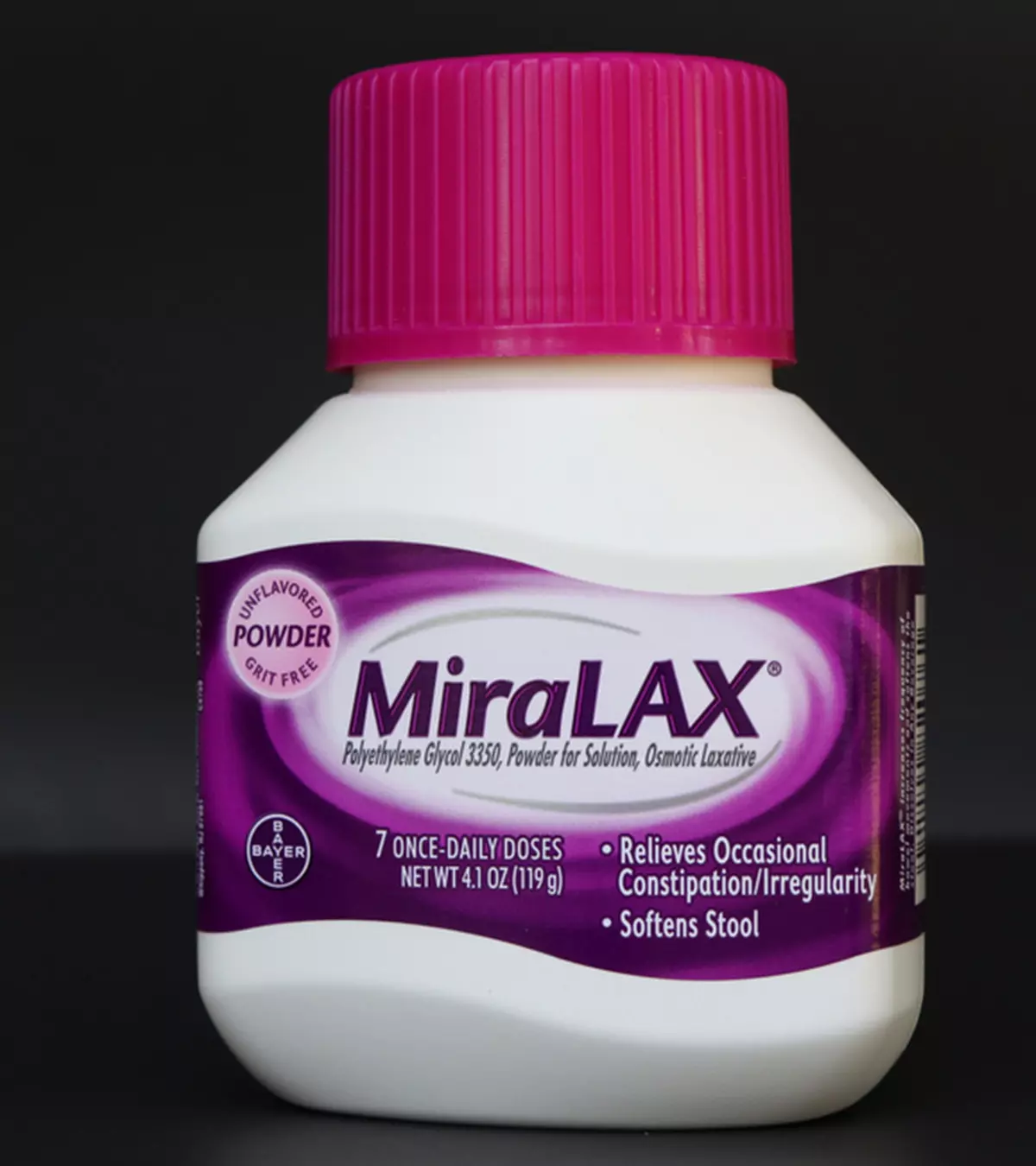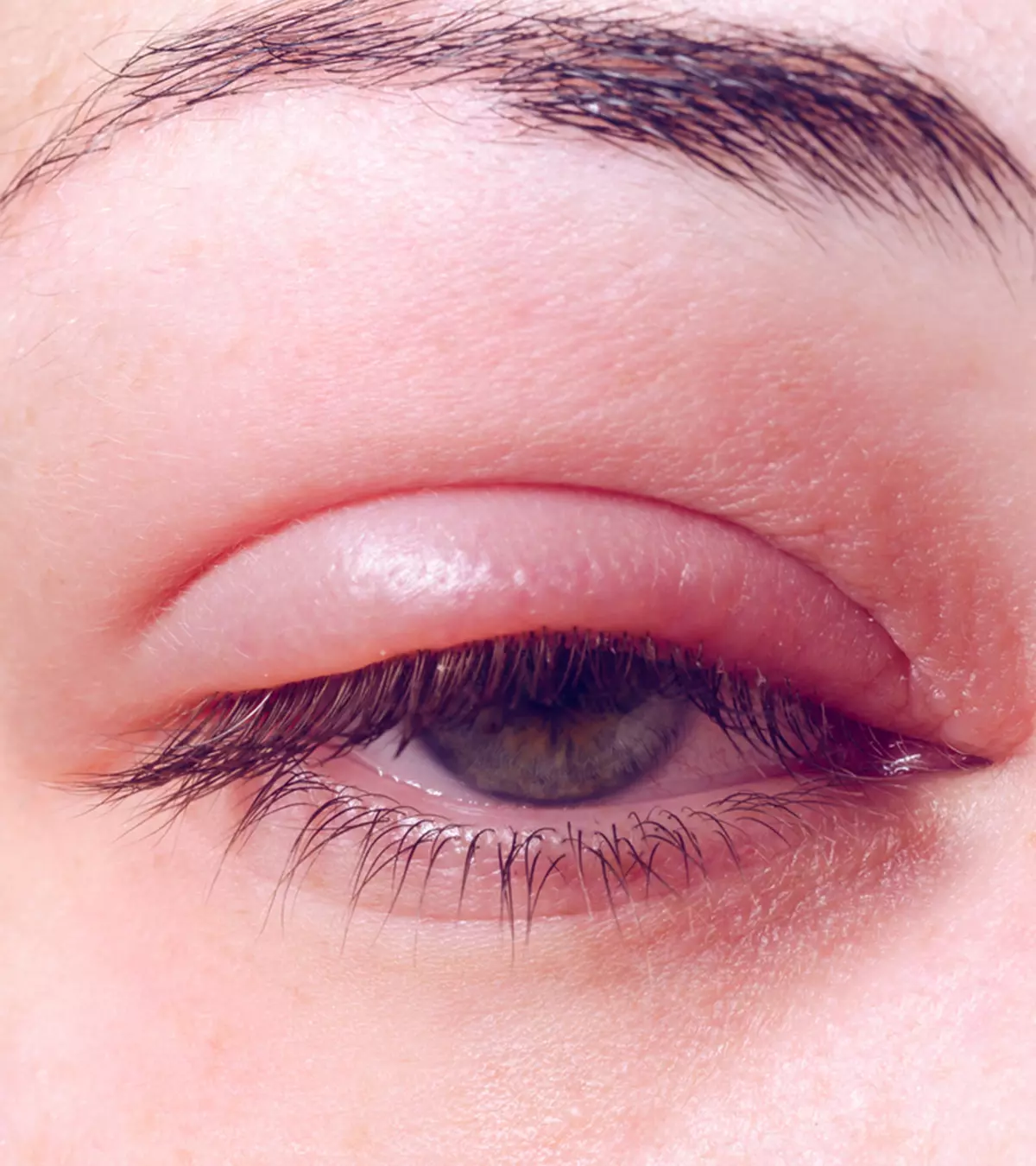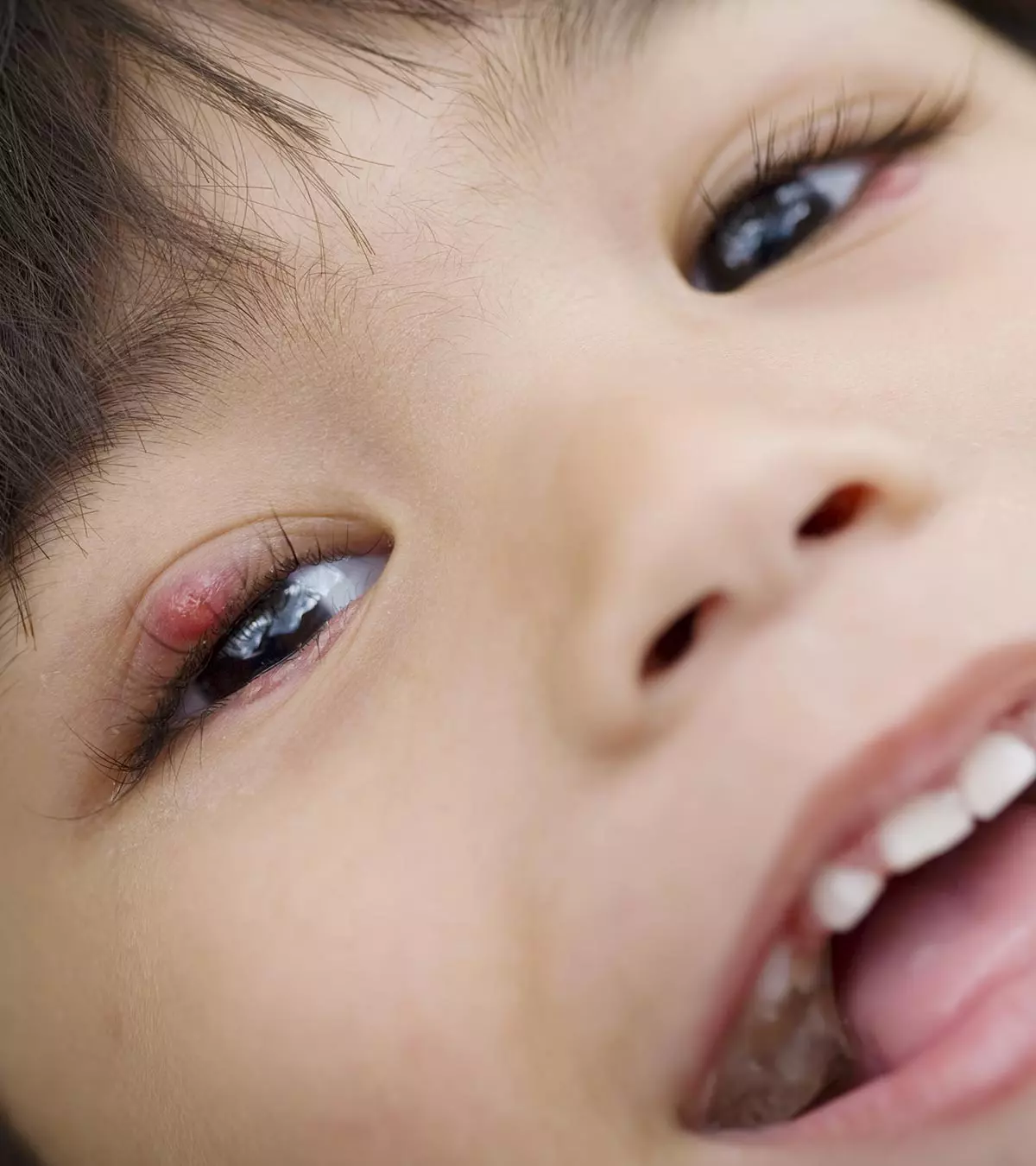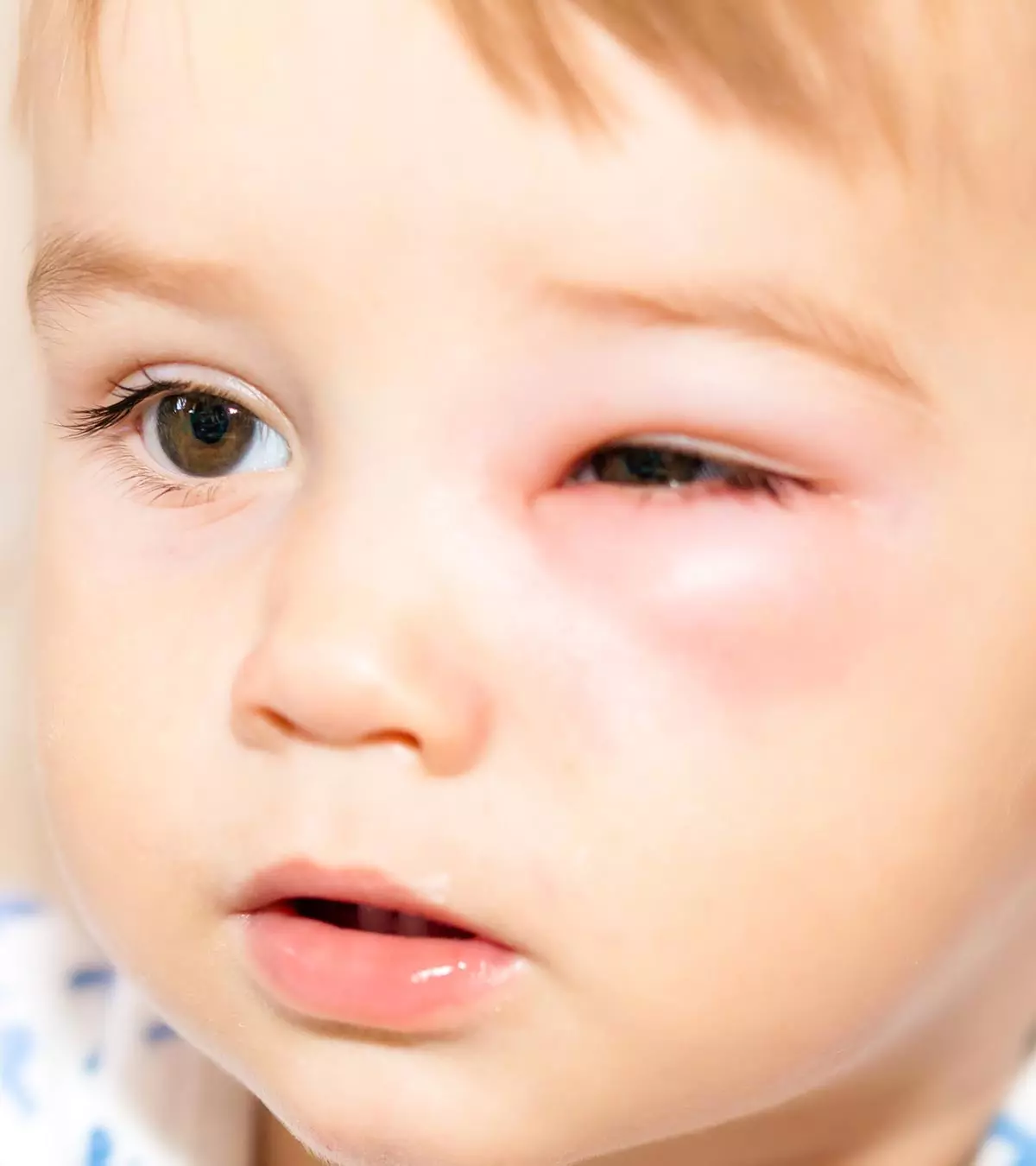
Image: Shutterstock
Children’s normal body temperature ranges from 97.5°F to 99.5°F (36.4°C to 37.4°C). Low-grade fever in kids occurs when the body temperature is between 99.6°F and 100.3°F (37.5°C to 37.9°C). Alternatively, a fever occurs if the temperature is 100.4°F (38°C) or above (1). It’s important to note that these temperature ranges can vary from child to child.

Children may contract a fever due to several factors, ranging from changes in the weather to an underlying infection. If your young one is experiencing a low-grade fever but seems energetic and continues their normal activities, resting for a while will help them recover. However, if other symptoms accompany the low-grade fever, medical intervention is needed.
Understanding low-grade fever in kids is important, as it may signal the body’s response to infections or other health problems. By tracking fever patterns, parents can know when to seek medical help and ensure their child’s health is properly managed. Read this post to learn about the causes of low-grade fever in children and the symptoms to look out for.
Key Pointers
- A low-grade fever may indicate that your child’s body is fighting an infection or underlying illness.
- You may notice that your child urinates more frequently, looks dehydrated, has a headache, and complains of body pain and loss of appetite.
- The simplest method to identify a low-grade fever is to take the child’s temperature with a thermometer.
- Adequate rest, anti-fever medication, plenty of fluids, and a lukewarm bath may help children with low-grade fever.
Causes Of Low-Grade Fever In Children
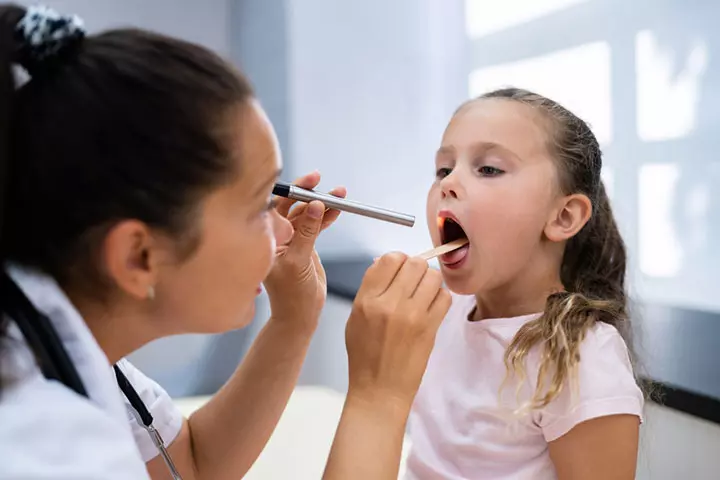
A low-grade fever could mean that your child’s body is trying to ward off an infection or an underlying disease. The following are some of the common reasons behind a low-grade fever.
1. Respiratory infections: When viruses and bacteria cause respiratory infections such as the common cold and influenza, the body tries to destroy such pathogens by increasing the body temperature. However, this protective mechanism against such infections could cause a low-grade fever (2). Low-grade fever in respiratory infections is usually not a cause for alarm unless accompanied by severe symptoms or prolonged duration. Respiratory failure from high carbon dioxide levels in the blood and infection spread to vital organs like the brain or heart are some uncommon complications of respiratory infections. Contact your healthcare provider immediately if you have concerns about your child’s symptoms (2).
2. Urinary tract infections: UTIs could be another potential cause of low-grade fever in your child. It is a bacterial infection anywhere in the kidneys, urethra, ureters, or bladder, characterized by a stinging sensation during peeing. A bladder infection could result in low-grade fever. However, if the infection spreads to the kidneys, other symptoms, such as night sweats, fatigue, chills, and fever above 100.3°F (38°C), may also occur (3). Most UTIs can be cured. However, if left untreated, UTI can lead to severe complications, such as kidney damage or scarring. In severe cases, it can lead to kidney infection (3).
3. Medicines and vaccines: A low-grade fever could be a side effect of a new medication. Such drug fevers could be due to hypersensitivity towards the medicine. Refer to the label of the medications to check if the new medicine could be the cause (4).
Similarly, immunizations are followed by an episode of a low-grade fever. A vaccine usually contains small amounts of inactive microbes that trigger the body’s immune system to strengthen the protective response. Therefore, a low-grade fever 24 hours after immunization is a good sign, as it suggests the vaccine has been effective. Such fevers last a day or two and can be treated with anti-fever medicines (5) (6).
Board-certified pediatrician Dr. Edward Kulich advises, “When a vaccinated child between 3 and 12 years of age gets a fever, several important factors should be considered, including their overall appearance and symptoms. If they look very ill, regardless of the fever’s height, they should be evaluated urgently.”
Julia, a mother of four children, discusses how her son Truman often gets a low-grade fever after vaccinations. She recounts, “Truman has always been a kid that feels teething and vaccines. After his 15-month shots, he had a low-grade fever and was super fussy, and then he had a little bug of some sort, too, with another low-grade fever and even more fussiness (i).”
 Quick fact
Quick fact4. Cancer: A persistent low-grade fever for weeks or months could be a symptom of underlying cancers, especially leukemias and lymphomas. A fever is a rare symptom of cancer. If the fever lasts for more than three days, you may alert your medical professional (7).
5. Stress: A low-grade fever caused by psychological stress is called psychogeniciSomething that has a psychological origin instead of a physical origin fever. According to the US Department of Health and Human Services, family conflicts could increase the risk of illnesses, which could cause a fever (8). Chronic stress-related fevers may lead to worsened mental health, fatigue, and weakened immunity, making children prone to infections.
6. Tuberculosis: TB is an airborne contagious disease spread by the bacteria Mycobacterium tuberculosis. A low-grade fever is a common symptom of tuberculosis in children (9). Diseases in the central nervous system are the most serious problems caused by TB, with about 50% of people affected experiencing severe illness (10).
According to the CDC, in 2025, children under 15 years of age accounted for 4% of tuberculosis (TB) cases in the United States. Specifically, there were 317 cases of TB disease among children aged 14 years or younger that year (11).
7. Autoimmune diseases: Usually, the body treats an external agent as a pathogen. But in an autoimmune disease, the body presumes the healthy cells as pathogens and attacks them. Rheumatoid arthritis and multiple sclerosis are common autoimmune diseases in children, and a low-grade fever is a common early symptom (12).
8. Meningitis: Meninges are thin membranes that enclose the brain and spinal cord. Inflammation of the meninges due to bacterial and viral infections leads to meningitis, which can further trigger low-grade fever in children (13). According to the World Health Organization (WHO), untreated meningitis can result in severe brain damage, hearing loss, or seizures. Prompt diagnosis is crucial to avoid adverse outcomes (14).
9. Other infections or chronic diseases: Here are a few other infections that could cause a low-grade fever (15).

- Gastrointestinal infections such as food poisoning or parasitic infections in the GI tract
- Childhood infections such as mumps (a viral illness that affects the salivary glands), chickenpox (a contagious viral infection that causes blisters on the skin), and measles (a viral respiratory illness caused by rubeola)
- Tonsillitis (the inflammation of tonsils due to bacteria)
- Other bacterial throat infections such as scarlet fever (accompanied with a rash) and strep throat
- Cellulitis (bacterial skin infection)
- Thyroiditis (inflammation of the thyroid gland)
Symptoms Of Low-Grade Fever In Children
Low-grade fever in kids has multiple etiologies; the symptoms could be specific to the underlying cause. Nevertheless, here are a few of the common symptoms (1) (15).
- Decreased frequency of urination
- Dehydration (when loss of body fluids is more than the intake)
- Headache
- Body pain
- Sunken eyes
- Dry mouth
- Loss of appetite
When To See A Doctor
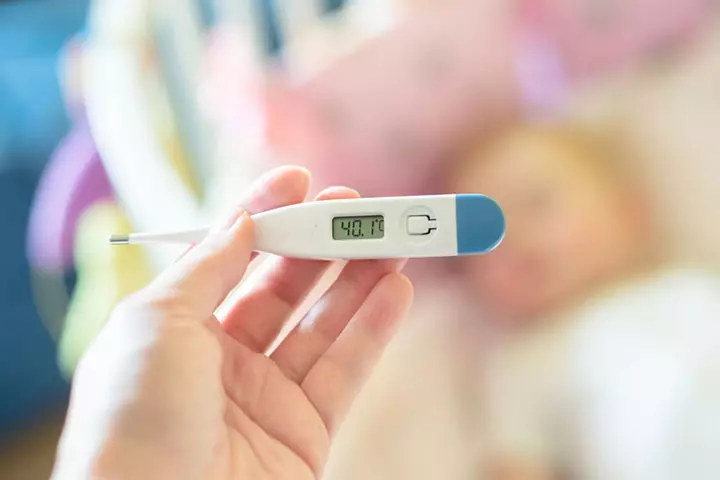
A child could have a fever ranging between 102°F to 103°F. Sometimes, they may have a fever as high as 103°F and perform their routine activities with regular energy. However, stay vigilant, and if any of the following symptoms accompany a fever, visit your healthcare provider (16) (17) (18).
- Sore throat, cough, runny nose, blood in sputum, and fatigue
- A fever for more than three days
- Temperature above 104°F
- Persistent fatigue even after good rest
- Difficulty in walking and breathing
- Seems confused or makes no eye contact,
- PhotophobiaiHeightened sensitivity and discomfort in eyes due to bright light (fear of light)
- Seizures
- No response to fever-reducing pills
- Pneumonia and bronchitis
- Viral illnesses such as measles and whooping cough
- Foul-smelling urine, or pain and burning sensation while peeing
- Decrease in urine output
- AnorexiaiAn eating disorder characterized by unusually low weight, fear of weight gain, or trying hard to lose weight (loss of appetite)
- Enlarged lymph nodes (swelling seen on the side of the neck)
- Excessive night sweats
- Bone and joint pains
- Headache
- Abdominal pain, vomiting, and nausea
- Sudden and unintended loss of weight
- Unexplained lumps, rashes, and bruises on the body
- Vision and hearing problems
- Blood in sputum
- Fatigue
 Be watchful
Be watchfulDiagnosis Of Low-Grade Fever

The best way to diagnose a low-grade fever is by measuring the child’s temperature using a thermometer. You could opt for any of these thermometers (19).
- Digital thermometer, which is placed under the tongue or armpit or inserted into the rectum
- TympaniciRelated to the eardrum (ear) thermometer
- Temporal artery thermometer, which is placed on the forehead area
Your child’s doctor would ask about the symptoms observed and conduct a physical examination. They may also perform a few blood tests and take a urine sample to check for urinary tract infections.
Parents may also consider keeping a record of their child’s fever patterns, noting any related symptoms. This can provide the healthcare provider with detailed information during consultations, helping with accurate diagnosis and treatment planning.
Treatment For Low-Grade Fever In Children
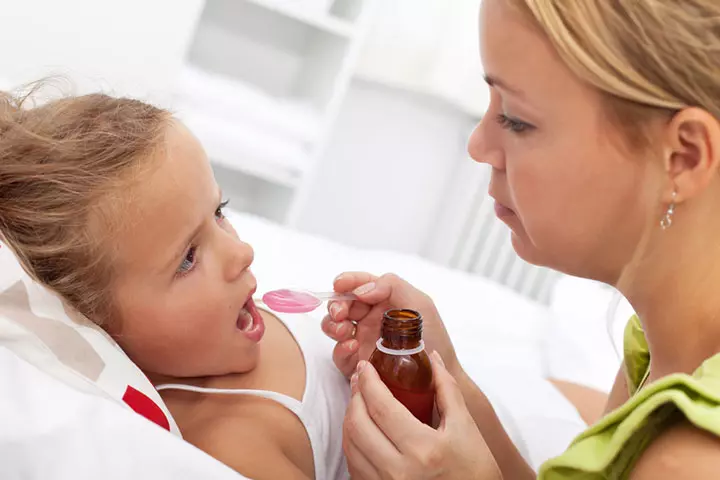
If viral infections in children cause a low-grade fever, proper rest, drinking plenty of fluids, and taking a lukewarm bath are often advised. You could also give them an anti-fever pill, such as acetaminophen or ibuprofen. Children under 17 years should not be given Aspirin as it may cause Reye's syndromeiA rare disorder that affects multiple organs and leads to severe liver and brain damage. (20) (21).
Board-certified diplomate of the Philippine Pediatric Society Dr. Maria Carmela Villania-Mamauag recommends, “When a child has a low-grade fever (99.6 – 100.3°F or 37.5 – 37.9°C) but remains active, well-hydrated, and able to perform daily activities, it’s best to monitor and manage the temperature. Measures like giving paracetamol or acetaminophen, tepid sponge baths, keeping the child hydrated, and offering energy-rich foods will help keep them comfortable during low-grade fever.”
Based on the type and severity of the infection, your pediatrician may suggest some additional interventions such as antibiotics or antiviral drugs.
Antibiotics and increased fluid intake are often suggested for UTI. If the underlying cause is chronic, the treatment would include extensive medical interventions.
 Quick tip
Quick tipFrequently Asked Questions
1. Are children contagious with a low-grade fever?
Yes, sometimes children may be contagious with a low-grade fever, especially if they have other symptoms such as a body ache or cold. Therefore, they must return to school or daycare only when they are fever-free for 24 hours, without taking any fever-reducing medications (22).
2. Can my child have a low-grade fever and not be sick?
Yes, a child could feel okay with a low-grade fever, which may resolve without treatment. Moreover, a child’s body temperature might vary and be higher during some phases of the day, including afternoon and evening (23).
3. Can teething cause a low-grade fever in infants and toddlers?
Teething does not cause fever in infants and toddlers. It can slightly raise your child’s body temperature. But this temperature will not come under the category of low-grade fever (24).
4. What are the dietary recommendations for children with low-grade fever?
When children have a low-grade fever, it is important to ensure they stay hydrated. Encourage them to drink plenty of fluids to prevent dehydration. Oral rehydration solutions can be used. Additionally, offering soup, ice pops, and flavored gelatin can help replenish fluids. It is advisable to avoid beverages with caffeine, such as colas and tea, as they can worsen dehydration (25).
Low-grade fever in kids may occur when the body tries to fight infections or underlying health conditions. There can be a slight increase in the body temperature in respiratory and urinary tract infections after taking certain medications and vaccinations. Stress and autoimmune conditions may also cause a low-grade fever. You may measure temperature using a thermometer and seek pediatric care if your young one has an increased temperature or accompanying symptoms. Doctors may prescribe fever medications and medications to treat the underlying causes.
Infographic: When You Should Not Worry About Your Child’s Fever
Fever in children can be worrisome, and a low-grade one may not necessarily mean that the illness is not concerning. However, there are specific apparent indications that can help you relax and not panic about your child’s fever. So use this infographic to spot the signs of an unalarming fever and prevent inessential medications.
Some thing wrong with infographic shortcode. please verify shortcode syntax
Illustration: Reasons For Low Grade Fever In Kids: Symptoms And Treatment
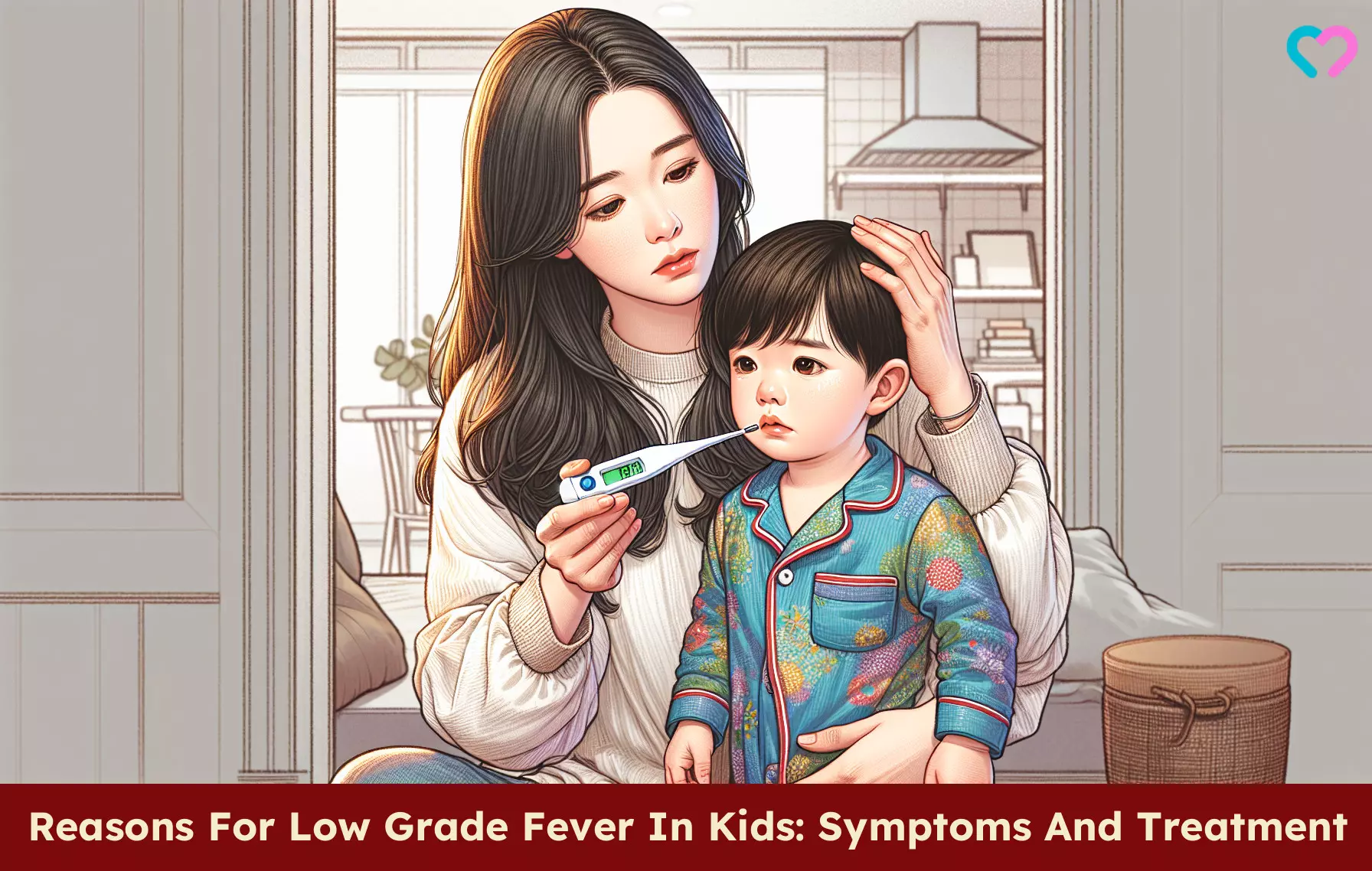
Image: Dall·E/MomJunction Design Team
Personal Experience: Source
MomJunction articles include first-hand experiences to provide you with better insights through real-life narratives. Here are the sources of personal accounts referenced in this article.
i. Sixteen months.https://julia-transition.blogspot.com/2011/07/sixteen-months.html
References:
- Fever.
https://www.cedars-sinai.org/health-library/diseases-and-conditions/f/fever.html - Upper Respiratory Tract Infections.
https://my.clevelandclinic.org/health/articles/4022-upper-respiratory-infection - Urinary Tract Infections (Children’s)
https://www.pennmedicine.org/for-patients-and-visitors/patient-information/conditions-treated-a-to-z/urinary-tract-infection - Tabor P A; Drug-induced Fever.
https://pubmed.ncbi.nlm.nih.gov/3522163/ - How do vaccines work?
https://www.who.int/news-room/feature-stories/detail/how-do-vaccines-work - Immunization Reactions.
https://www.seattlechildrens.org/conditions/a-z/immunization-reactions/ - Childhood cancer.
https://www.who.int/news-room/fact-sheets/detail/cancer-in-children - Chronic Family Stress Linked to Illness in Children
https://www.nih.gov/news-events/nih-research-matters/chronic-family-stress-linked-illness-children - T Anane and J P Grangaud; 1992; Diagnosis of tuberculosis in children.
https://pubmed.ncbi.nlm.nih.gov/12345139/ - Tania A Thomas; (2017); Tuberculosis in Children.
https://pmc.ncbi.nlm.nih.gov/articles/PMC5555046/ - Reported Tuberculosis in the United States, 2025.
https://archive.cdc.gov/www_cdc_gov/tb/statistics/reports/2025/demographics.htm - Autoimmune Diseases | Symptoms & Causes.
https://www.childrenshospital.org/conditions-and-treatments/conditions/a/autoimmune-diseases/symptoms-and-causes - Meningitis.
https://dph.illinois.gov/topics-services/diseases-and-conditions/diseases-a-z-list/meningitis.html - Meningitis.
https://www.who.int/news-room/fact-sheets/detail/meningitis - A Sahib El-Radhi; Fever in Common Infectious Diseases.
https://www.ncbi.nlm.nih.gov/pmc/articles/PMC7122655/ - Symptoms & Causes of Bladder Infection in Children.
https://www.niddk.nih.gov/health-information/urologic-diseases/urinary-tract-infections-in-children/symptoms-causes - Kids’ Fever: When to Worry
https://health.clevelandclinic.org/kids-fevers-when-to-worry-when-to-relax - Signs And Symptoms Of Cancer.
https://www.cancer.org/cancer/diagnosis-staging/signs-and-symptoms-of-cancer.html - Fever
https://www.cedars-sinai.org/health-library/diseases-and-conditions/f/fever.html - Fever
https://my.clevelandclinic.org/health/symptoms/10880-fever - Aspirin.
https://www.versusarthritis.org/about-arthritis/treatments/drugs/aspirin/ - How long am I contagious?
https://vitalrecord.tamu.edu/how-long-am-i-contagious/ - Fever and Your Baby.
https://www.healthychildren.org/English/health-issues/conditions/fever/Pages/Fever-and-Your-Baby.aspx - Teething
https://www.seattlechildrens.org/conditions/a-z/teething - Fever (High Temperature) In Kids
https://kidshealth.org/en/parents/fever.html
Community Experiences
Join the conversation and become a part of our nurturing community! Share your stories, experiences, and insights to connect with fellow parents.
Read full bio of Dr. Kishor Tewary
- Dr. Maria Carmela Villania-Mamauag is a board certified diplomate of the Philippine Pediatric Society with a degree of Doctor of Medicine from Our Lady of Fatima University, Valenzuela City and a Bachelor in Science in Psychology from Saint Louis University, Baguio City which was augmented by a year of Bachelor in Science in Family Life and Child development at the University of the Philippines, Diliman, Quezon City.
 Dr. Maria Carmela Villania-Mamauag is a board certified diplomate of the Philippine Pediatric Society with a degree of Doctor of Medicine from Our Lady of Fatima University, Valenzuela City and a Bachelor in Science in Psychology from Saint Louis University, Baguio City which was augmented by a year of Bachelor in Science in Family Life and Child development at the University of the Philippines, Diliman, Quezon City.
Dr. Maria Carmela Villania-Mamauag is a board certified diplomate of the Philippine Pediatric Society with a degree of Doctor of Medicine from Our Lady of Fatima University, Valenzuela City and a Bachelor in Science in Psychology from Saint Louis University, Baguio City which was augmented by a year of Bachelor in Science in Family Life and Child development at the University of the Philippines, Diliman, Quezon City. - Dr. Edward Kulich is a board-certified pediatrician, a fellow of the American Academy of Pediatrics, and the American Academy of Home Care Physicians. He obtained his Doctor of Medicine from St. George's University School of Medicine, completed a residency in Pediatrics at Maimonides Medical Center, Infants and Children’s Hospital of Brooklyn, and maintains privileges at Cornell, Lenox Hill, Mt. Sinai, and NYU hospitals. He has over 15 years of experience and is the current president of the American Academy of Concierge Pediatricians. Dr. Kulich is the author of The Best Baby Sleep Book and The Best OLSAT Book.
 Dr. Edward Kulich is a board-certified pediatrician, a fellow of the American Academy of Pediatrics, and the American Academy of Home Care Physicians. He obtained his Doctor of Medicine from St. George's University School of Medicine, completed a residency in Pediatrics at Maimonides Medical Center, Infants and Children’s Hospital of Brooklyn, and maintains privileges at Cornell, Lenox Hill, Mt. Sinai, and NYU hospitals. He has over 15 years of experience and is the current president of the American Academy of Concierge Pediatricians. Dr. Kulich is the author of The Best Baby Sleep Book and The Best OLSAT Book.
Dr. Edward Kulich is a board-certified pediatrician, a fellow of the American Academy of Pediatrics, and the American Academy of Home Care Physicians. He obtained his Doctor of Medicine from St. George's University School of Medicine, completed a residency in Pediatrics at Maimonides Medical Center, Infants and Children’s Hospital of Brooklyn, and maintains privileges at Cornell, Lenox Hill, Mt. Sinai, and NYU hospitals. He has over 15 years of experience and is the current president of the American Academy of Concierge Pediatricians. Dr. Kulich is the author of The Best Baby Sleep Book and The Best OLSAT Book.
Read full bio of Sindusha MS
Read full bio of Dr. Ritika Shah
Read full bio of Dr. Joyani Das







